Can chickens fly? And how high?
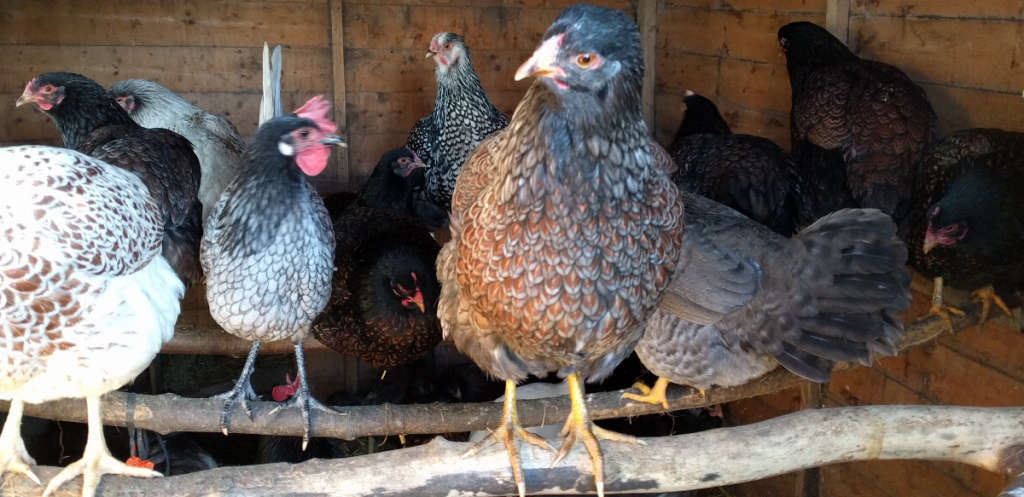
Yes. Most chickens can fly but not far. I have around 300 chickens across 22 different breeds at the moment and some will whilst some won't.
Chickens fly to escape predators, roost at night and to make their foraging easier. All chickens except the naked necks have a full complement of feathers and most will use them at some point.
Silkies are the only chicken that can not fly, they are missing the stiff quills in the middle of their feathers.
A chicken will generally only fly to a point it can see clearly like a branch or the top of a fence post. They also tend to fly up to a perch and then fly down rather than doing the whole thing in one go.
Some Chicken Flying Facts: The longest recorded flight of a chicken was 13 seconds and the furthest recorded distance was 301.5 feet. Chickens are agile can run at 9 to 10 mph.
Below: This chicken flew happily on to her coop roof.
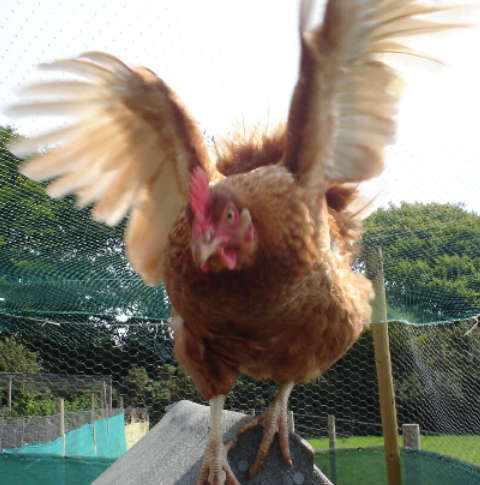
As you know chicks grow in their primary flight feathers somewhere after 3 weeks depending on the breed. Some chicken breeds feather up faster than others.
I have had many a laugh watching my chicks first flights as they try out their little wings, most of which end in a heap of feathers or a tumble along the ground. It is all part of their learning process for later in life.
They can and will perform bursts of high intensity short range flights into the trees, or to avoid local squabbles or if startled or to arrive at the food trough first.
Do chickens fly in the wild.
It's a survival thing. Our modern domesticated birds come from the wild jungle fowl of Asia and in the wild it is completely natural for them to fly. But not far as they live in a forest and the need is to be ale to fly into a tree.
So chickens can fly. Not very high or far, but they do fly. They don't get much practice and are selectively bred for other qualities like eggs and meat. You would not have hens in your backyard if they only laid 40 eggs a year and escaped every time you let them out.
Chickens, Guinea fowl and turkeys are all members of the large group of gallinaceous birds (order galliformes). Gallinaceous birds are mostly ground-dwelling and take to the air only to evade predators or other dangers.
All modern chickens are descended from jungle fowl which are a forest dwelling bird. The need to escape a predator by flying to the nearest tree or from one tree to another is what has driven their evolution.
Chickens, turkeys and guinea's will roost for the night in trees or other elevated places high above the ground and safe from most ground based predators. In the evening as it gets dark they will fly from the ground up to their night-time resting places. There is quite a lot of flapping about and moving around before the settle into their perch for the night.
Staying on the ground would be far too dangerous.
Are chickens good flyers?
No chickens are not good flyers at all, this is a list of the characteristics that effect a chickens ability to fly:
- Their body - They are round and the wings are set quite high. This is and adaptation to give long powerful beats to get them off the ground quickly. The cost is streamlining and stamina.
- Wingspan and weight - A Barnevelder hen weighs in at 6 to 7 pounds and the rooster 8 to 10 pounds but chickens of this breed have a wingspan of 3 feet. This gives them a very high wing loading as they have a high body weight to wing surface area ratio. Compare to a bird like a hawk which has a body weight of around 3 pounds but a wing span in excess of 4 feet.
- The eyes - the really good flyers in the bird world have eyes forward on their heads. Think owls and the like. Chickens have eyes on the sides of their heads. Good for all round vision and looking for predators but a bit crap for flying. This is why chickens often crash to the ground with heavy bump rather than graceful landing.
- Ancestry - Chickens were bred from a wild species call the red jungle fowl which were somewhat better filers than the modern bird. Their food is on the ground and the eyes and beak have adapted to match. Their feet are adapted for walking and perching.
- Selective breeding - Humans have been tinkering with the chicken for hundreds of years. modern breeds are not a natural. They were created by selective breeding the red jungle fowl to bring out or accentuate desired characteristics. This is artificial selection natural selection as they underwent in the wild. Chickens have been selected for egg or meat production and not their ability to survive.
The flapping climb:
Most chicken keepers with and escape specialist in their flock have seen this one.
It consists of flapping walk up the chain link fence to the top and they can accomplish this even with a clipped wing.
Why do chickens fly?
Chickens feel the need to take to the skies for several reasons:
- Predators - Startling a chicken will see it leaping into the air in a flurry of flapping to see it escape.
- Curiosity - The grass is always greener and belongs to a neighbour. Hens are intensely curious creatures and love to investigate new things especially if it might be food dust bath related.
- Determination - Some are just more stubborn than others.
- A mate - Rooster getting after hens. I struggle with this one a lot when I pen up my birds for breeding.
- Snow - My chickens dislike snow and it upsets them. You get a lot of clucking and then a flight to the feeder.
- Avoidance - Avoiding fights and confrontations.
Do some breeds of chicken fly better than others?
Most breeds of chicken can fly but not all choose to. The ability of a chicken to fly is usually determined by their breed type and their own personal preference. Some prefer it more than others and some are just too heavy ever to get their bodies off the ground.
Table below: Chickens flying ability by breed.
| Breed of chicken. | Flying ability. |
| Altsteirer | The Alsteirer is a good flyer. |
| Ameraucana | The Ameraucana is a little smaller and lighter and as such is a good flyer. It will easily get into trees and onto rooftops. |
| Ancona | Anconas are a light and streamlined breed of chicken and is a good flyer. |
| Andalusian | My Andalusians are good flyers always loved to be up high and never had any trouble getting onto roofs and over walls |
| Appenzeller Spitzhauben. | The Appenzeller Spitzhauben is a light, small framed chicken that is a good flyer. |
| Arucuana. | The Arucuana is a medium sized chicken with good flying ability. |
| Asil / Aseel. | The Aseel is a large, tall but not heavy chicken that can fly very well if it needs to. As it was originally bred as a fighter, it will fly to get to another cockerel. |
| Ayam Cemani. | Ayam Cemani chickens are light, nimble and flighty and can easily get over any fences. |
| Barnevelder. | The Barnevelder is a large full bodied chicken that has smallish wings set high on the body and is a very bad flyer. |
| Black Rock. | The black rocks is a modern hybrid layer. Both it's parent breeds are good flyers and the black rock has a light frame. A good flyer by chicken standards. |
| Booted Bantam. | Booted Bantams are very good flyers despite looking the opposite. The downward wings are large with well developed chest muscles. They are calm and docile and rarely seem to see the need to take to the air. |
| Bovans Hybrids. | A red sex linked hybrid that is lightweight and a good flyer when it needs to. |
| Brabanter. | Mine never had any trouble getting up to my shoulders. Brabanter are good flyers despite the large crest and seem to like being up high. |
| Brahma. | The Brahma is a large, heavy chicken and somewhat clumsy flyer. They may even need help getting onto high roosts. |
| Brakel. | Brakel chickens are good flyers. They are slim active birds which have no trouble getting into the trees. |
| Breda | A full bodied larger chicken, the Breda is an average flyer. |
| Bresse. | La Bresse Gauloise chickens are a heavy meat type that is not a good flyer. Even getting down off perches can be clumsy and awkward. |
| Burford Brown | The Burford Brown is a modern Marans hybrid of average flying ability. |
| Campine. | Campines are a hardy, light breed of chicken known to be flighty. They will get over fences, walls and onto roofs without any problem. |
| Cinnamon Queens. | Cinnamon Queens are a modern red sex linked hybrid. Being such a light bird, they fly surprisingly well but generally choose not to. |
| Cochin. | The Cochin is a large heavy chicken that can barely fly at all. My Cochins only ever flew up to the perches and were awkward and clumsy in the air often rolling over when landing. |
| Cream Legbar. | My cream legbars are surprisingly good flyers, when it suits them. The hens in particular will only fly if they have to. |
| Crevecoeur. | The Crevecoeur is a good flyer and one of those breeds that need a covered run if you want to keep them in. |
| Croad Langshan. | The Croad Langshan is a heavy breed that does not fly well. They are easy going and seem happy to stay put. |
| Derbyshire Redcap. | Being a wary chicken, the Derbyshire Redcap is a good flyer that often takes to the wing. |
| Dominique. | The Dominique is a large dual purpose chicken that can fly when it has to. It is not a good flyer and mostly does the flapping hop. |
| Dorking | The Dorking is a well built, heavy dual purpose chicken that can not fly well. |
| Dutch Bantam | The dutch bantam has large wings for such a small bird and is an excellent flyer compared to other types of chickens. My Dutch bantams have been to the top of a two storey house and covered 50 yards or more in one flight. |
| Easter eggers. | Easter eggers vary in their ability to fly as they are not a standardised breed. Average flying ability. |
| Faverolles. | The Faverolles is a meat bird that does not fly well. They are chunky, heavy and clumsy in the air. |
| Fayoumi. | The Fayoumi is an average flyer in chicken terms. |
| Friesian | Friesians are a light dutch breed that fly well and will get over chicken fence with ease. |
| Frizzle. | Frizzle chickens have curly feathers and do not fly well at all. Mine never even tried to fly beyond roosting at night. |
| German bush fowl. | My German bush fowl are excellent flyers |
| German Langshan. | The German Langshan is a large heavy breed that is not a good flyer at all. |
| Golden comets. | Golden comets are light weight modern red sex linked chickens that fly well but generally choose not to. |
| Gold tops. | Gold tops are a Silkie cross that can fly. How well depends of how much Silkie feathering they inherit. |
| Hamburg. | My Hamburgs were like pigeons and always seemed to be fluttering around. Hamburg chickens are excellent flyers that do it for fun. |
| Houdan. | The Houdan can and does fly. The large crest hampers the birds vision and apart from roosting at night the prefer not to fly at all. |
| Hy-Line. | Hy lines are a modern red sex linked hybrid. Being such a light bird, they fly surprisingly well but generally choose not to. |
| Indian (Cornish) Game. | As a meat chicken, Indian game birds do not fly much at all as they are to heavy. Keepers must take care not to stress the birds out so as they do not try to fly. They do not even like to roost at height. |
| ISA Brown | The ISA brand of chickens are modern red sex linked hybrids. Being such a light bird, they fly surprisingly well but generally choose not to. |
| Ixworth. | The Ixworth is a meat bird and a poor flyer. |
| Japanese Bantam. | My Japanese bantams are quite good flyers for chickens being regular escapees. |
| Jersey Giant. | Jersey Giants are in the can just fly but do not bother category. The Jersey Giants is a large, heavy breed that struggles to get to high perches. |
| Ko-Shamo. | Shamo are all poor flyers. Not known to be flyers except in an emergency. Clumsy on the wing because of their upright shape. |
| Kraienkoppe. | The Kraienkoppe is an average flyer that ordinary chicken fence will keep contained. |
| Lakenvelder. | The Lakenvelder is a smaller bird with powerful wings that flies moderately well for a chicken. Runs will need to be covered with this breed. |
| Leghorn. | Leghorns are good flyers. |
| La Fleche. | La Fleche is a active chicken and an average flyer. Being a dual purpose bird it is well covered. Mine never had any trouble getting on to their 8 foot high shed roof. |
| Lohmann Brown. | The Lohmann breeds are a modern red sex linked hybrid chickens. Being such a light bird, they fly surprisingly well but generally choose not to. |
| Malay. | The Malay is a large and very tall breed that can not fly. Their size, bulk, stance and sparse feathering makes it difficult to to even get onto perches. |
| Marans. | The Marans is a heavy bird that can fly on occasion but not for any distance or to any great height. Mine get up their 6 foot high perches with no problem. |
| Marsh Daisy. | The Marsh Daisy is an average flyer that seems to prefer to be on the ground. |
| Minorca. | Minorca chickens are good flyers. Mine can easily get to two metres high and cover the 80 yards down the field to get to me when thy think I have treats for them. |
| Modern Game. | The Modern game is a poor flyer preferring to use its long powerful legs in combination with a flap of the wings to get where it wants to be. Modern Game chickens will struggle to get above 4 foot. |
| Modern Langshan. | The Modern Langshan has powerful breast muscles and can fly to quite some height. They have little stamina and can not fly far. getting over fences is easy for them. |
| Nankin. | Nankin bantams are good flyers. |
| New Hampshire Red. | The New Hampshire Red is a dual purpose and heavy chicken making it a relatively poor flyer. New Hampshire Red bantams are much better flyers. |
| Norfolk Grey. | The Norfolk Grey is an average flyer. |
| North Holland Blue. | The North Holland Blue is a large chicken with an average flying ability. It can get over fences if panicked or determined. |
| Old English Game. | Old English Game are good flyers for chickens. They have no trouble getting into trees and over fences if the fancy takes them.. |
| Old English Pheasant Fowl. | Old English Pheasant Fowl are legendary flyers in the chicken world. They easily get into the tallest trees and like to be up high. |
| Olive eggers. | Olive eggers vary in their ability to fly as they are not a standardised breed. Average flying ability that depends on parent stock. |
| Orpington. | All types of Orpington chickens are poor flyers. Their size and feathering means they can struggle to get onto high perches. |
| Pekin. | The Pekin bantam is a terrible flyer. The fluff and shape mean all but a powered hop is out of the question. |
| Penedesenca | The Penedesenca is a light framed Mediterranean breed which is a good flyer. |
| Plymouth Rock. | Plymouth rocks are a full figured chicken with higher set wings making them poor flyers. |
| Poland. | My Polish chicken refuse to fly for the most part as the crest obscured their vision. They can fly however and always get up to the perches to roost. |
| Rhode Island Red. | The Rhode Island Red is an average flyer. |
| Rosecomb. | The little Rosecomb bantam is a good flyer in the chicken world. |
| Rumpless Araucana. | Despite lacking the tail feathers for steering in flight, the Rumpless Araucana flies quite well. |
| Rumpless Game. | Rumpless Game chickens are poor and clumsy flyers. |
| Russian Orloff. | The Russian Orloff is a bit too heavy to be able to fly well or far. |
| Scots Dumpy. | The Scots dumpy is an average flyer. |
| Scots Grey. | The Scots grey is a a good flyer. |
| Sebright. | My Sebrights are good flyers. Bantams as a rule fly better than large fowl and my Sebrights are light and flighty. |
| Serama | The Serama flies better than you think. Different classes of Serama have different flying abilities. The slim flies quite well and dragon not so much. |
| Shamo. | All shamo are poor flyers. Their upright stance, long legs and sparse feathering makes them clumsy and limited to powered jumping. |
| Sicilian Buttercup. | The Sicilian Buttercup is light and agile and a good flyer. They get over fences with ease and will need a covered run. |
| Silkie. | Silkies are really poor flyers and lack the stiff quills in their feathers to be able to fly. That said mine get onto the perches and to the top of fence posts |
| Spanish. White faced black. | The Spanish White faced black is an active, light framed Mediterranean breed which is a good flyer. |
| Speckledy. | The Speckledy is a modern hybrid that can fly okay. They are quite a heavy bird and prefer to walk. |
| Sulmtaler. | The Sulmtaler is a relatively good flyer.. |
| Sultan. | The Sultan is a below average flyer. The, stance, crest and excess foot feathering make for a clumsy flyer that prefers to stay put. |
| Sumatra. | The Sumatra is a good flyer in the chicken world. They are sleek and have large powerful wings and the full tail makes them graceful in the sir |
| Sussex. | My Sussex were never good flyers, they were too bulky to get over fences. About 4 foot is their limit. |
| Transylvanian Naked Neck. | Transylvanian Naked Necks are almost flightless. The shape, small weak wings and lack of feathers make actual flight all but impossible for this breed. |
| Vorwerk. | The Vorwek is a good flyer that will need a covered run if you want to keep them confined. |
| Welsummer. | The Welsummer and all its crosses,like the Welbar are average to below average flyers. |
| White Star. | White stars are a leghorn based hybrid and are excellent flyers. |
| Wyandotte. | The Wyandotte is a large heavy dual purpose chicken that does not fly well and p[refers to keeps its feet on the ground unless roosting for the night. |
| Yokohama | The shape and long heavy tail feathers of the Yokohama make it a graceful but below average flyer. |
Bantams are the best flyers. My German bush fowl are always roosting in trees rather than join others in the hen house at night.
Lighter bodied breeds like Araucanas and Vorwerks are good flyers, and some just seem to enjoy flying, or at least trying to.
Heavy breeds such as Orpingtons and Wyandottes hens may fly about a foot off the ground for a very short distance but their wings cannot give them the lift power needed for the size of the hens body.
If you have ever stood a distance from your birds and offered treats, you will have seen the heavier breeds covering the ground With an excited flapping run, wobbling about madly in the rush to see what interesting treats you have.
It’s the Mediterranean breeds like Ancona's and Leghorns that tend to be known as flighty birds. They have harder feathers, are more streamlined and lighter.
How far can chickens fly?
Domestic chickens are not good flyers - their body weight is too heavy for their wings to carry them any distance. They tend to do a kind of hop and flap motion which is not in the slightest elegant or graceful.
I have seen mine cover 100 yards down the field to see what I have for them but that field slopes downward giving them he advantage of a higher start.
How high can chickens fly?
Chickens are good flyers can get to a height of 6 metres easily. Most chickens will struggle to get to 2 metres high.
My Chickens are very sociable and happy to see me as I generally have food for them. They get excited and fly down the field to see me in the morning. They will all try to be first especially if there is feed involved.
Below: These chickens are roosting around 8 foot high in a shed.
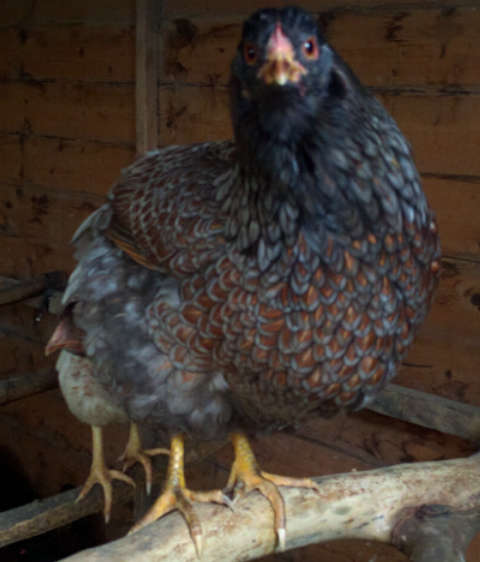
So I have personal experience of them flying up to ten or fifteen feet high when they really want to get somewhere.
Not all are that energetic, though, and the heavier breeds won't be able to get anything like that high. My Light and Speckled Sussex, Marans and Wyandottes don't bother trying to fly at all - but my bantams love to roost as high as possible.
But for those breeds that like to fly, four feet is easy for them. Six is getting more difficult but still very possible, even for the medium sized birds.
The Italian livonese is small, white and looks a bit like a large dove but with a red crest. They were typically kept in vineyards and orchards where they could sleep on branches.
At what age can chickens fly?
They start flapping their wings from a few days old and from around 3 weeks of age the chicks begin to develop wing feathers. As the chicks are small and light they can cover some quite large distances and can easily get on top of cupboards and the like.
Below: A Barnevelder chick perching two foot up on a box edge.

Depending on the breed the flight feathers - the long feathers on the leading edge of the wing - start growing at day three or four after hatching and are fully developed by the age of between five and ten weeks.
Are fences chicken proof when it comes to flying?
Nope. Very high fences are more difficult for heavier breeds, but lighter breeds and bantams will fly over fences with no problem.
Below: A chicken flying over a six foot wire fence with no trouble.
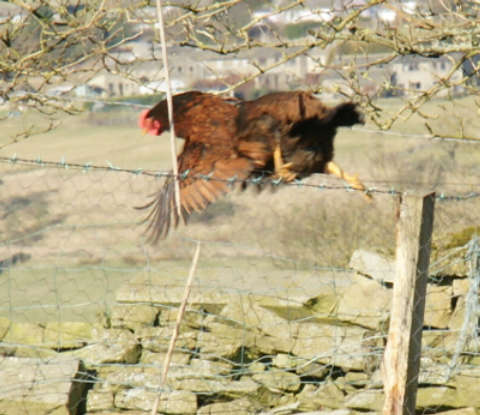
In fact, some of my own girls flew over our six foot high fence even after they'd had one wing clipped. Everything I'd read said they should not be able to fly with one wing clipped. I didn't know how they were doing it until I sat and watched them.
They hopped onto a branch on a small willow tree I had in the run and the flew to the top of a six foot fence post.
I would add that once the chicken is in the tree they are glide quite well and they’re funny to watch. It takes a huge amount of effort for them to move their heavy bodies with short round wings, but gliding they do well.
If you live in a town and have a few hens in your back yard, your neighbours might not be terribly pleased that their lovely green lawn is being raked over by your marauding flock.
Hens are ruthless when it comes to grass - they can clear a patch in minutes! And neighbours definitely won't be pleased that your girls have chomped down on their veggie patch, or used their lovely summer flower pots as dust-baths.
Can roosters fly?
Yes, roosters fly, normally better than the hens of the same breed. Cockerels do it to show off, tend to be more muscly and have the benefit of testosterone in their system. They also have more reason if there are ladies on the other side of the fence.
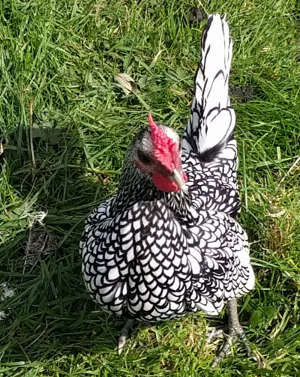
Above: This Seabright cockerel is a very good flyer and has a thing for the ladies, any and all he can get to.
Are there any chickens that can not fly?
Commercial meat chickens have been so selectively bred for their size and fast growth that they have almost lost the ability to stand, let alone fly. This is a la Bresse meat bird from France. They are heavy and well built and struggle to get themselves off the ground at all.
Below: Meat chickens like this La Bresse can not fly at all.
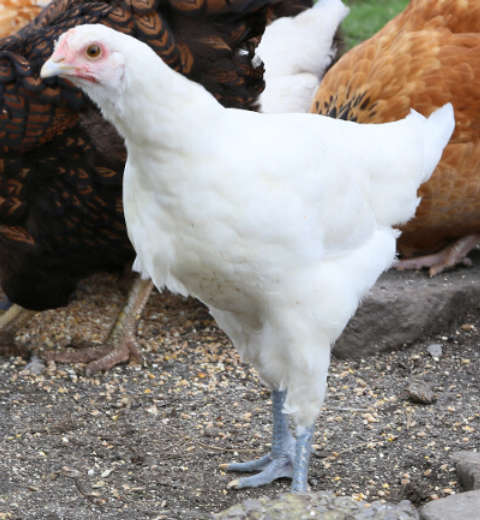
My Silkie bantams can not fly at all being limited to powered hops. They do enjoy the exercise though and will happily flap about.
My Polish hens can but can't see much through the crest so choose not to. They are also haughty and think flying is vulgar.
My Orpingtons choose to stay on the ground and need steps to get to high perches for roosting.
I was quite surprised at this cream crested legbar, as she was a large breed of about 7 lbs. She made it happily 12 foot up to the first branch and then up a few more branches into the top of the tree.
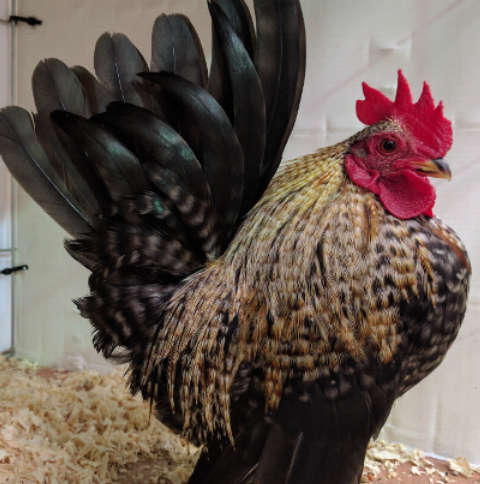
Above: My tiny Seramas are sleek and bred for their shape and I have seen them get 12 feet into the air over distances of about 20 feet.
What you can do to stop a chicken flying?
How to stop chickens flying. If you are a keeper lighter bodied hens like leghorns you might find the odd one roosting quite happily in a tree. It is the remnants of that inherited instinct to roost up high.
Escapees cause problems. Unhappy neighbours, plants and vegetable gardens destroyed. Your chickens putting themselves at risk of attack from the waiting mouths of predators, the neighbours Labrador or eating something poisonous.
How to Trim Chicken’s Feathers:
Trimming the large Primary flight feathers is one way to try and limit the flying ability of your chicken. Cut them down in and arc to within and inch and a half of the wing on one side only. This unbalances the bird as it tries to take flight
It doesn't always work, some really determined hens have proven to their owners that they can still fly despite wing trimming and some get used to the disability you inflicted on them.
Wing trimming is a personal thing. Some folks don’t believe in it, others swear by it. My flock is free range so I prefer them to be able to take to the skies if they need to. There is always one that doesn't like being confined to the breeding pens and needs its feathers clipping.
The usual trimming involves the primary flight feathers only and seems to work well as a deterrent for most birds. You can trim the whole wing for a persistent offender.
Wing trimming is not a permanent solution as the bird moults every year and the new feathers that grow in will need to be trimmed again.
It is important to remember that when you trim the adult feathers you are cutting through hollow quills. If you cut emerging pin feathers after the moult you will cause pain and bleeding.
Brailing:
This technique is controversial and I have never used it and nor do I intend to but if you have exhibition birds, wing trimming will disqualify them from showing. There is a second technique to prevent chickens from flying, brailing.
Brailing involves wrapping or binding one wing with some material so that the wing cannot be opened and used for flight. It is important ensure the binding is not too tight and constricts the blood flow and secondly, switch the brail from one wing to the other every few days or so.
Placing a restrictive device on the wing can cause injury or disability if done improperly and make them susceptible to predators.
If you have exhibition birds that like to fly, brailing may be the answer but it is probably easier to cover your run.
This is almost certainly illegal in the UK and Europe as it interferes with the 5 freedoms that chickens are entitled to in law.
Summary:
So yes, Chickens can fly and each individual is likely to be different. I have some that never fly anywhere and other that struggle to stay on the ground.
Some will continue to try no matter how you try to contain them it’s the wild jungle fowl genes coming out and the only truly effective way to keep them contained is a covered run area or a fence so high that it is impossible to get over.
If you keep only heavier breeds in a well secured area, you are unlikely to have many problems with your ladies wandering across to the neighbours.
If you have ‘flighty’ breeds, I’m sure you might have already had them trying to escape.
